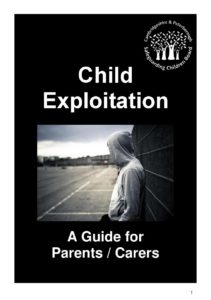Exploitation is a form of abuse. It occurs where an individual or group takes advantage of an imbalance of power to coerce, manipulate or deceive a child or young person under the age of 18 into any activity
- in exchange for something the victim needs or wants, and/or
- for the financial or other advantage of the perpetrator of facilitator and/or
- through violence or the threat of violence.
Specific types of exploitation includes:
- Modern Slavery (including human trafficking)
- Sexual Exploitation
- Criminal Exploitation
- Financial Exploitation
The victim may still be exploited even if the activities that they are engaging in appear consensual.
Multiple types of exploitation can occur alongside or as part of other forms of abuse.
Exploitation does not always involve physical contact; it can also occur through the use of technology.
Virtual Briefings
Guidance, Procedures and Assessment Tools
Contextual Risk Screening Tool
Leaflets
Young people are often unaware that they’re being exploited until it’s too late.
Parents are unlikely to be aware of what is happening.
Spot the signs and know what to do if a child is being exploited


‘Reproduced by kind permission of Merseyside’s Violence Reduction Partnership. www.merseysidevrp.com’







Information for Businesses on Child Sexual Exploitation
Guidance
Guidance for professionals to be used when discussing the exploitation of children and young people, including when escalating intelligence and delivering training

Guidance for Families, Professionals and the community to help understand how intelligence can build a picture of current trends or patterns

For information and resources for working with children at risk of Sexual Abuse, please visit out Child Sexual Abuse page
